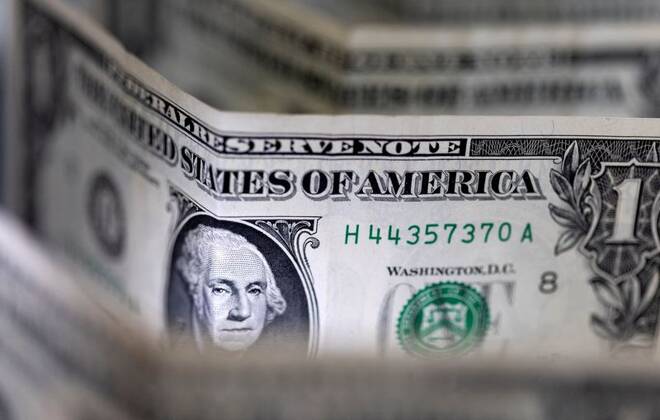Advertisement
Advertisement
Column: Extreme dollar a wake-up call for earnings outlook – Mike Dolan
By:
By Mike Dolan LONDON (Reuters) - The U.S. dollar's rampant surge may finally force corporate America to wake up to a brewing earnings recession.
By Mike Dolan
LONDON (Reuters) – The U.S. dollar’s rampant surge may finally force corporate America to wake up to a brewing earnings recession.
The investment puzzle of the summer so far is how spiking inflation and interest rates have darkened economic forecasts while barely denting the outlook for company earnings growth over the next 18 months.
As Wall St’s top investment banks scramble to place odds on a looming recession – with many seeing at least a couple of consecutive quarters of U.S. economic contraction as inevitable and others placing a 50-50 chance on a worldwide downturn – the ‘bottom up’ view from boardrooms has remained weirdly sanguine.
And that’s why the start this week of the second-quarter earnings season and attendant forward guidance is awaited with such bated breath – not least for a full readout on the post-Ukraine invasion energy shock and climbing interest rates.
To date, ‘top down’ recession calls have not been matched by an equivalent earnings rethink.
Aggregate S&P500 earnings growth for this year is still in excess of 10% and even after slipping about half a percentage point over Q2, it remains above 9% for all of 2023.
“Economists and investment market strategists are unusually united in their predictions that recession is an inevitability,” said Jim Wood Smith at Hawksmoor Investment Management.
“The fly in their ointment is that no one appears to have told businesses,” he added. “The next two or three weeks will go a long way to resolving this tension.”
This may be just a lag of course as equity analysts hesitate in front of deteriorating macroeconomic calls and wait for their companies to tell them the bad news first hand.
Or it could be more fundamental than it seems.
One glimpse into the peculiarly distorted state of the economy right now could be seen in the latest survey of U.S. small businesses – showing sentiment in June at its lowest since 2013 but demand for labor still robust as executives continue to grow operations.
And yet for larger multinationals with overseas earnings, something more immediate is pressing an alarm – the blinding appreciation of the U.S. dollar against other major currencies as Federal Reserve tightening goes into overdrive while other central banks drag their heels.
As extreme as it gets
While most market watchers are currently in thrall to the euro’s slide to parity for the first time since 2002, dollar strength is pervasive against most other currencies such as Japan’s yen and Britain’s pound and its broader DXY index is at its highest in 20 years.
There has only been four full calendar years over the past four decades in which the dollar index has gained more than 12% and it’s exceeded that already in 2022 so far.
Rolling year-on-year gains of more than 17% in DXY are already their highest since 2015. Annual gains of more than 20% are extremely rare since the mid-1980s – only in 2015 and very briefly both in 2009 after the banking crash and during the dotcom bubble and bust in 2000.
Morgan Stanley’s strategists dusted off their ‘ready reckoners’ this week to show how earnings hurt from a dollar move that’s “as extreme as it gets historically speaking”.
They concluded that every percentage point increase in the DXY index year-over-year saps S&P500 earnings-per-share growth by half a point – suggesting an 8.5 point headwind for EPS growth over the past 12 months.
“This could not be coming at a worse time as companies are already struggling with margin pressure from cost inflation, higher/unwanted inventories, and slower demand.”
The fear is this amplifies a slashing of both corporate guidance and 12-month earnings forecasts and means the 20%-plus drop in stock prices so far this year may not have been enough to reduce historical overvaluation.
If the ratio of prices to forward earnings rises again as a result, another leg down in prices may still be necessary to fully price recession risks and keep multiples down to even historical averages.
Even though the 16x forward PE right now is almost 30% off last year’s peaks, it’s still about 6 points above the trough during the recession of 2008/2009.
Goldman Sachs’ rule of thumb is that a ‘moderate recession’ – to which it ascribes a 30% chance over the coming year – would see EPS decline 11% to $200 in 2023, or some 20% below current consensus.
Assuming consensus EPS estimates moved half way there by the end of this year, a drop in multiples to 14x should see the S&P500 fall another 15-20% over the next six months, it said.
Spinning that out globally, Citi strategists see current consensus earnings growth forecasts of 11% this year and 7% next year falling to less than 5% – but reckon it could be worse, given there’s a 50-50 chance of a world recession in that time.
“Even that will be too bullish if global recession hits.”
The author is editor-at-large for finance and markets at Reuters News. Any views expressed here are his own
(by Mike Dolan, Twitter: @reutersMikeD; Editing by Mark Potter)
About the Author
Reuterscontributor
Reuters, the news and media division of Thomson Reuters, is the world’s largest international multimedia news provider reaching more than one billion people every day. Reuters provides trusted business, financial, national, and international news to professionals via Thomson Reuters desktops, the world's media organizations, and directly to consumers at Reuters.com and via Reuters TV. Learn more about Thomson Reuters products:
Advertisement
